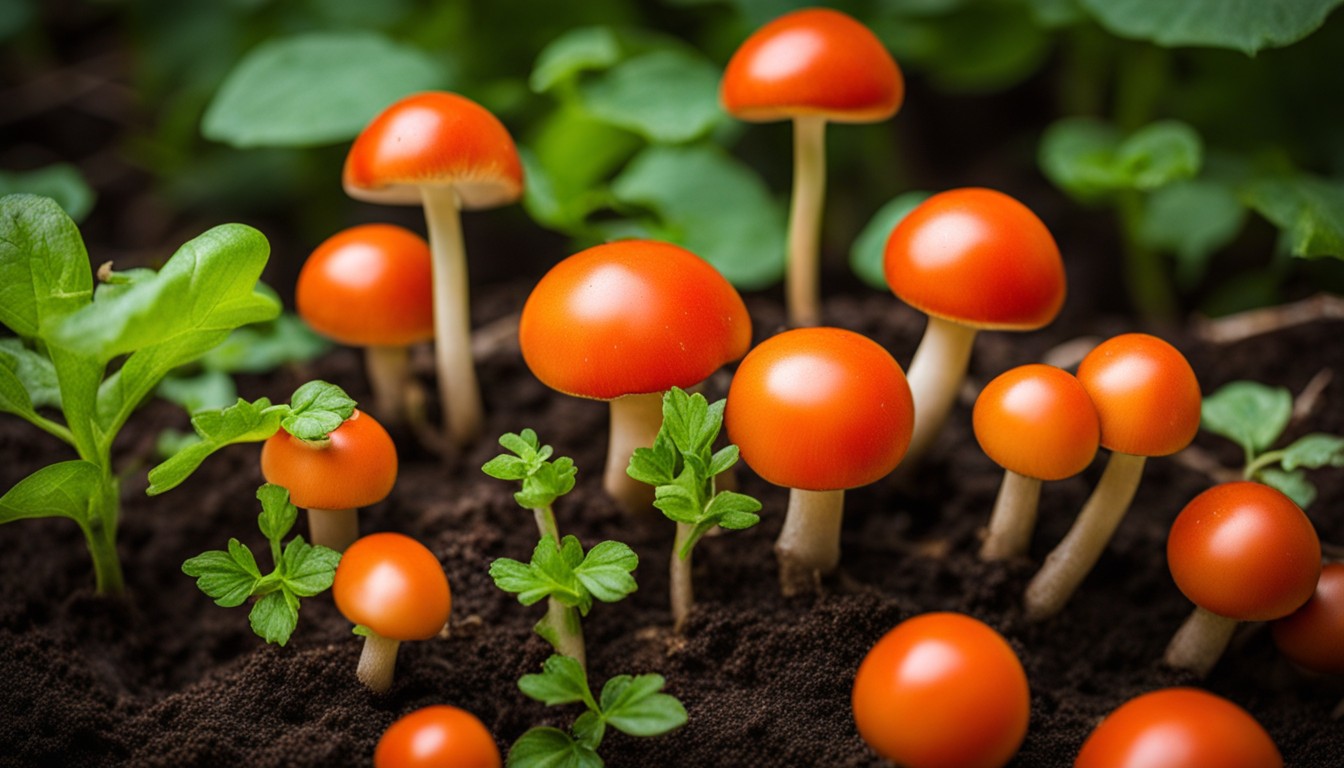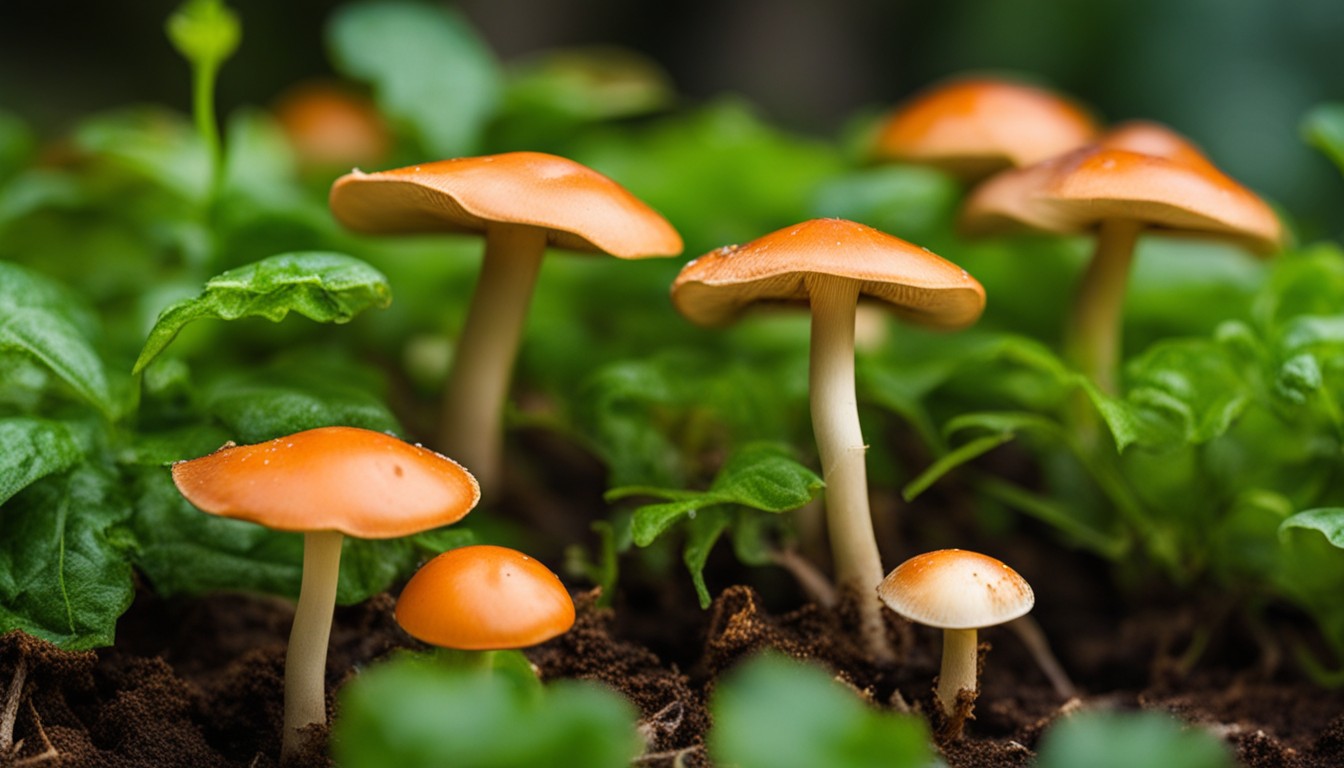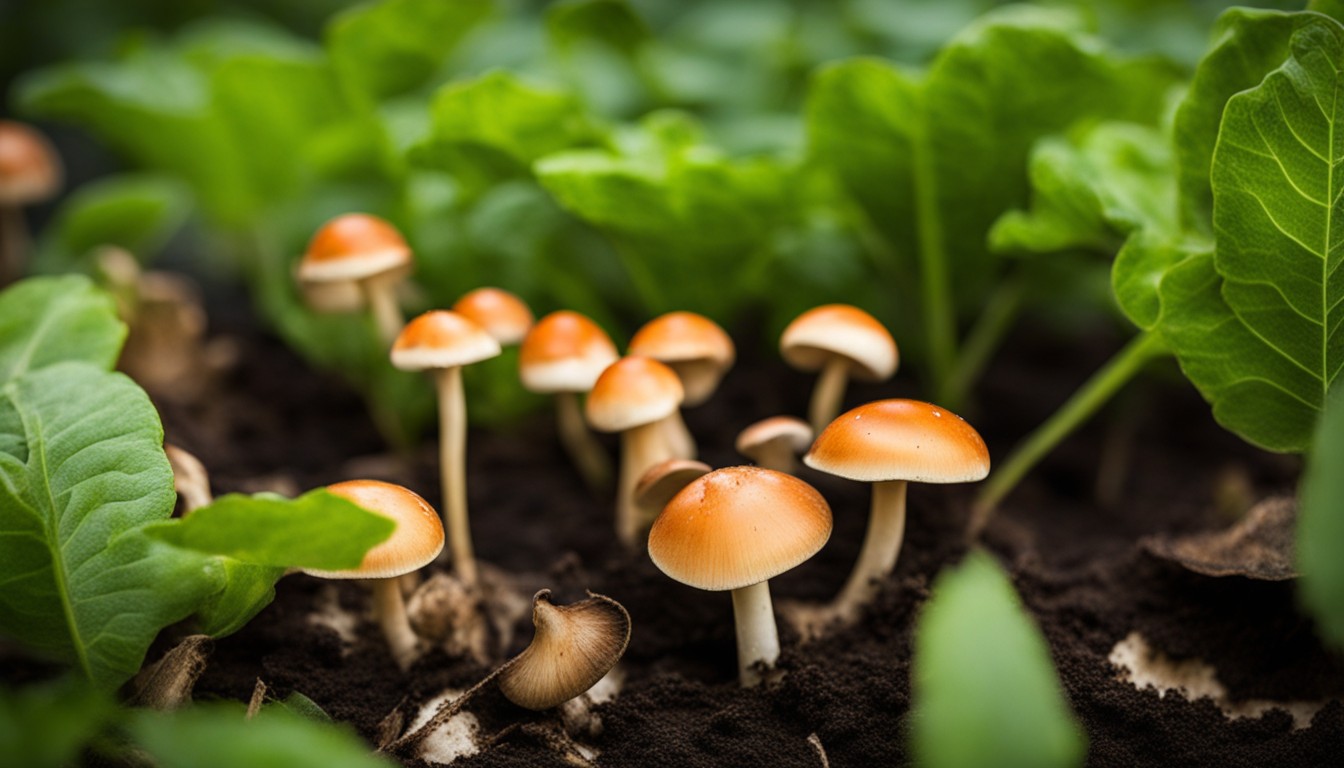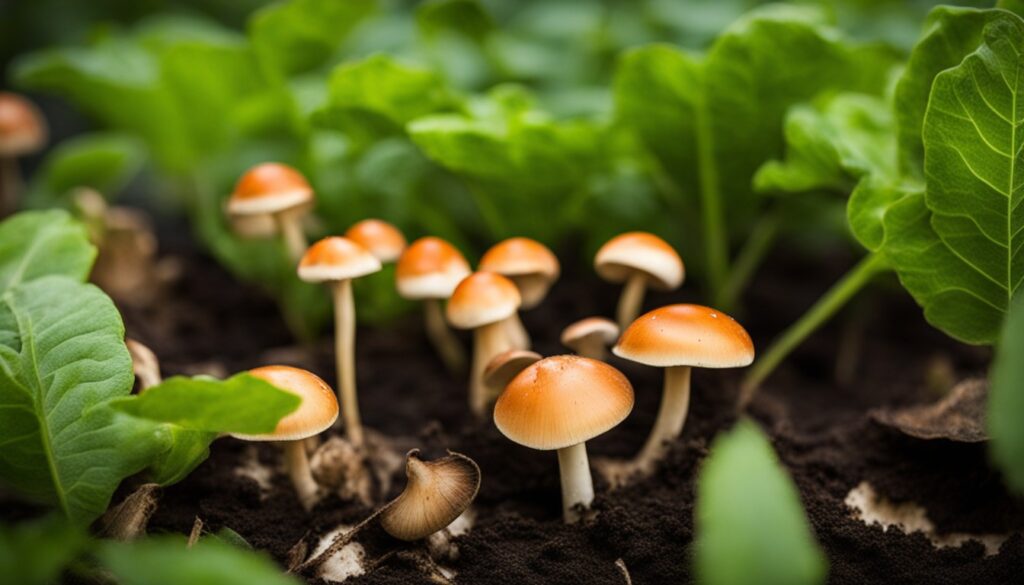Mushrooms in tomato plants can be a perplexing phenomenon for gardeners. Understanding why these fungi appear and how they affect tomato plants is crucial for optimal plant health. In this blog post, we will delve into the various factors that contribute to the growth of mushrooms in tomato plants and provide expert tips on how to manage and prevent their occurrence. Gain a comprehensive understanding of this fascinating botanical occurrence and equip yourself with the knowledge needed to maintain thriving tomato plants in your garden.
Why Do Mushrooms Grow in Tomato Plants?
The ecology that underpins the association of fungi and plants is a complex web of interdependence. Certain mushrooms thrive in the rich, organic soil that tomato plants favor, visualizing a picture of inherent mutualism.
Tomato plants’ nurturing features create an ideal ecological niche, luring specific mushrooms to thrive in their rich, organic soil, hence forming a symbiotic relationship.
Simply put, tomatoes are a preferred host for certain mushrooms because they offer a fertile environment. The nutrients, water, and shade provided by these plants present an ideal ecological niche for mushroom growth.
Understanding the Symbiotic Relationship
Mushrooms serve crucial roles in the life cycle of tomato plants. As decomposition organisms, they break down organic matter, releasing nutrients into the soil that help promote robust plant growth.
In fact, the science behind this fascinating interaction is based on a symbiotic partnership termed mycorrhizal relationships. These associations involve a mutual exchange — tomato plants provide sugars to mushrooms, while mushrooms furnish essential minerals to the plants.
Such relationships not only reduce plant stress but also equip tomato plants with enhanced ability to withstand unfavorable environmental conditions, exemplifying an intricate network of survival and mutual sustainability.
Factors Contributing to Mushroom Growth
Soil conditions hugely impact mushroom growth. Ample organic material and moisture in soil foster mushroom proliferation. Interestingly, the decomposing organic matter in soil offers necessary nutrients, encouraging mushroom spores to grow.
Climactic factors also play a significant role. Cooler, humid conditions promote the growth of fungi, including mushrooms. Thus, during the wet seasons or in cooler climates, an escalation of mushroom growth might be observed.
Sometimes, mushrooms may emerge following changes in soil pH. Certain fungi are attracted to acidic environments, so a shift towards a lower pH may stimulate mushroom growth.
Furthermore, overwatering can cause mushrooms to grow due to the heightened moisture levels. Regular irrigation can often lead to excessive dampness in the soil, creating a conducive environment for fungi.
No less significant is the influence of light. Dim lighting, associated with overcast or shady conditions, can accelerate mushroom development. Therefore, practicing optimal light exposure may assist in controlling mushroom growth.
Types of Mushrooms Found in Tomato Plants

Mushroom identification in your tomato garden is critical for managing their impact on plant growth. The symbiosis often varies, from beneficial fungi like Trichoderma species, promoting root development, to harmful species like Fusarium causing wilts and growth retardation.
Common Mushroom Species
In the ecosystem of a tomato plant, a variety of mushrooms may flourish. These fungi introduce both mutual advantages and potential hazards in the plant’s growth environment.
- Leucocoprinus birnbaumii, also known as the Yellow Houseplant Mushroom, often appears in potted plants and provides organic material via decomposition.
- Psilocybe cubensis is an infamous species due to its psychoactive properties – not generally harmful to the tomato plant but certainly requiring proper handling.
- Lycoperdon pyriforme or Pear-shaped puffballs, harmless to your plants, can help in breaking down organic matter.
Identifying Edible Mushrooms
In tomato plantations, it’s essential to know how to discern edible mushrooms from potentially harmful ones. Knowledge of identifying features, such as cap shape, gill structure, spore print color, and stem characteristics, gives growers a clear line of demarcation.
- Look for mushrooms with rounded, flat, or convex cap structures, which are often indicative of edible variants.
- Identify the gill structure, typically located beneath the cap. Safe-to-eat mushrooms commonly display attached or free gills.
- Inspect the mushroom’s spore print. Edible mushrooms usually produce white, cream, or light pink spore prints.
- Observe the stem characteristics. Edible mushrooms generally possess stems with a ring, while poisonous ones often lack this feature.
Identifying Invasive or Harmful Mushrooms
Invasive or harmful mushrooms in tomato gardens can be recognized with distinct hallmarks. A solid protocol is crucial for identifying such mushrooms that may pose risks to your tomato patches.
- Noting unusual growth patterns, such as rapid spread or large clusters
- Observing changes in the foliage, stem, and fruit of your tomato plants
- Recognizing uncommon mushroom colors such as bright red, yellow or purple which could indicate poisonous species
- Testing soil pH levels as some harmful mushrooms prefer certain pH conditions
- Keeping an eye out for sudden appearance after heavy rains, as some harmful mushrooms sprout in damp conditions
- Monitoring the overall health and growth of your tomato plants, as a sudden slow down may signal invasive mushroom species
The Impact of Mushroom Growth on Tomato Plants

The proliferation of mushrooms in your tomato plants can mark a significant effect on their health and vitality. This colonization, at times beneficial, can also significantly alter the plant’s growth patterns, nutritional value, and yield quantity.
The mushroom presence affects the tomato plants’ development considerably. Emphasizing the flexibility of this influence, it’s essential to observe that this growth could foster nutrient production and distribution within the plants but could also potentially encourage disease and pest infestation.
Effect on Tomato Yield and Growth
Mushrooms’ presence around tomato plants can lead to varied outcomes in yield and growth. Depending on the mushroom type, they can either contribute to an enriched soil ecosystem enhancing plant health or compromise tomato plants’ productivity.
Certain mushroom species form mycorrhizal relationships with tomato plants, improving their nutrient absorption capacity. Thus, this indirectly boosts yield and tomato growth by ensuring optimal nutrient utilization.
However, some parasitic fungi could negatively affect tomato plants by limiting nutrient availability or causing diseases. This can result in stunted growth and lower yields, stressing the need for close monitoring and controlling mushroom growth when required.
Beneficial or Detrimental Relationship
Analysing the symbiotic relationship between mushrooms and tomato plants is essential; some mushrooms stimulate nutrient exchange, fostering plant growth, while others can impair the health of the plant, leading to decreased yield. Furthermore, harmful mushrooms may introduce diseases that affect the plant’s vigor.
Deciphering this complex relationship demands understanding the type of mushroom species present. While certain types can enhance tomato plant productivity through effective nutrient cycling, others might adversely impact not just individual plant yields but even the broader ecosystem balance if not properly managed.
Managing Mushroom Growth in Tomato Plants
Excessive mushroom growth in tomato plants can be managed through a comprehensive understanding of factors such as moisture levels, general environmental controls, and the use of suitable organic or inorganic fungicides. A balanced approach ensures that tomato plants are protected while maintaining a natural ecosystem.
Prudent mushroom management in tomato cultivation involves techniques like rotation cropping and solar sanitization. Awareness about identification and removal of harmful mushrooms, paired with creating unfavorable conditions for their growth, can prove instrumental in promoting a healthy tomato crop.
Preventive Measures
Examining preventive strategies is crucial to hampering unwarranted mushroom multiplication in tomato gardens. These measures promote the health of tomato plants while minimizing the possibility of mushroom overgrowth.
- Regular inspection and timely removal of mushroom growth
- Proper water management to reduce excess moisture
- Maintaining appropriate distance between the plants to prevent overcrowding
- Applying organic matter to improve soil structure and aeration
- Rotating crops annually to interrupt the life cycle of fungi
- Proper sterilization of tools to avoid spreading spores
- Pruning lower leaves to improve air circulation
Controlling Mushroom Growth
Effectively controlling mushroom growth in your tomato plants involves the careful use of modern tools to ensure you deescalate mushroom proliferation without inadvertently causing harm to your tomato plants. This balance of power is key to successful growth moderation in modern-day tomato farming.
- Invest in soil sterilization equipment to curb spore growth
- Use straw mulch to regulate soil temperature and moisture
- Manually remove large, visible mushrooms from the soil
- Rotate crops to disturb mushroom growth cycle
- Consider using fungicides specifically designed for tomato plants, always following the manufacturer’s instructions
Using Fungicides, If Necessary
Despite the beneficial aspects of some mushroom types, invasive or harmful mushrooms may necessitate the use of fungicides. Careful assessment is essential to determine their necessity and potential impact on the overall health and productivity of the tomato plants.
Fungicide application should be undertaken with extreme caution. Its use must be judiciously balanced with the plant’s needs, ensuring it controls adverse mushroom effects without harming the tomato plant or useful organisms.
Moreover, opting for organic or bio-fungicides can provide a safer avenue for managing harmful mushrooms. Such sustainable practices help in maintaining the overall ecosystem health while allowing the cultivation of quality tomatoes.
Cultivating Mushrooms in Tomato Plants

Switching your perspective can sometimes turn a problem into an opportunity. A gardener up for a unique challenge may wish to embrace the spontaneous mushroom growth and cultivate edible varieties within their tomato plants. With the right conditions, one can yield a dual harvest from the same garden patch.
Turning this fungal occurrence into an opportunity requires insight into mushroom cultivation. Knowledge of suitable mushrooms for the tomato environment, proper care, and ideal harvesting time can result in a bumper crop of both tomatoes and mushrooms. This unorthodox practice transforms the gardening experience and opens up possibilities for culinary ventures.
Creating the Right Growing Conditions
To effectively cultivate mushrooms symbiotically with tomatoes, the conditions must mirror that of their natural environment. This usually involves maintaining high humidity, steady temperatures, and diverse soil rich in organic material.
Environmental factors play significant roles. Sufficient sunlight is crucial for the growth of tomatoes, while mushrooms favour a shady, moist environment. Striking a balance between these contradicting requirements is key to successful co-cultivation.
Adjusting watering schedules may also be necessary. Tomatoes require regular, deep waterings, whereas mushrooms thrive on moderate but consistent moisture levels. A well-draining soil will help satisfy the needs of both entities in this cultivation blend.
Choosing Mushroom Varieties for Cultivation
Identifying suitable mushroom species for your tomato garden extends beyond mere preference. Factors such as climate and geological conditions necessitate specific choices and these selections can directly impact the health and productivity of your tomato plants.
Diversity in selecting mushroom species should not overlook their direct implications. For instance, varieties that are non-invasive or beneficial for soil health, like mycorrhizal fungi, should be prioritized to foster a vibrant and healthful growth environment.
Recognizing the unique characteristics that each mushroom variety brings to your tomato garden can shape an advantageous symbiotic relationship. Certain species aid in nutrient mobilization, helping the tomato plants absorb essential nutrients more efficiently.
Looking at the mushroom species’ own growth requirements acts as a guiding tool. Opt for varieties that thrive in similar conditions as your tomato plants. This ensures mutual growth and reduces conflicts of interest between the two species.
The decision also gravitates towards their contributions. Mushrooms like the ‘Wine Cap’ not only coexist with tomato plants but also discourage plant pathogens and pests, resulting in shared benefits for both species, making it an ideal selection.
Harvesting and Utilizing the Mushrooms
Mastering the art of mushroom harvesting is critical to ensure tomato plant growth remains undisturbed. The fungi should be plucked carefully from the base, making sure not to root out any attached soil or impact the base of the tomato plants.
After harvesting, mushrooms should be immediately placed in a cool and ventilated spot. This will help maintain their freshness until they are ready to be used.
Mushrooms harvested from tomato gardens have multifaceted uses, making them highly beneficial. They can be used in preparing a variety of dishes, enriching them with a unique earthy flavor.
Apart from culinary usage, these mushrooms can also be used as organic fertilizers. Composting them properly can yield nutrient-rich soil, beneficial for tomato growth in the subsequent planting season.
Maintenance and Care Tips for Mushroom-Infested Tomato Plants
To maximize productivity in a mushroom-infested tomato plant setting, implementation of advanced care techniques is crucial. This can include regulating watering, managing soil pH balance, the introduction of essential nutrients, and the selective pruning of the plant canopy to enable maximum sunlight penetration.
Providing consistent care is a key determinant for mushroom-tomato co-cultivation’s long-term success. Regular monitoring of plant health indicators, such as leaf color and fruit size, can assist in quick detection and rectification of any adverse conditions.
Foster healthy plant growth by ensuring the soil is rich in organic matter and fungi-friendly. This will ensure that both the mushrooms and tomato plants have the nutrients they require to thrive.
Maintaining an optimal level of moisture is essential for mushroom growth, even more so than for other plant species. However, be cautious to avoid overwatering which could lead to plant disease and fruit spoilage, turning this beneficial relationship into a detrimental one.
Addressing potential infestations promptly can prevent the overgrowth of harmful mushroom varieties. Organic fungicides or biological control agents can be used when necessary to maintain a healthy balance, safeguarding the productivity of both mushrooms and tomatoes.
FAQ – Understanding Mushrooms in Tomato Plants
Mushrooms in tomato plants can be intriguing yet confusing. This FAQ provides insights into the influence of mushrooms on tomato plant health, growth, and yield. Learn how to identify, manage, and even cultivate these fungi effectively within your garden.
What causes mushrooms to grow in tomato plants?
Mushrooms in tomato plants typically result from organic matter decomposition in the soil, such as decaying roots or fallen leaves. The moisture and humidity levels in the environment also play a significant role.
Are mushrooms harmful to tomato plants?
In most cases, mushrooms in tomato plants are not harmful. However, some mushrooms can compete with the tomato plant for nutrients, potentially affecting growth and yield. It’s important to identify the specific type of mushroom to determine if any action needs to be taken.
How can I manage mushrooms in tomato plants?
Proper plant care, including adequate spacing, good air circulation, and regular maintenance practices like removing decaying organic matter, can help manage mushroom growth. Adjusting watering practices and using well-draining soil can also help prevent mushroom proliferation.
Can I cultivate mushrooms intentionally in my tomato garden?
Yes, it is possible to cultivate mushrooms intentionally in your tomato garden. However, this requires specialized knowledge and techniques. It’s crucial to research specific mushroom species, growing conditions, and techniques before attempting cultivation.
Are all mushrooms edible and safe to consume?
No, not all mushrooms are edible and safe to consume. Some mushrooms can be highly toxic or cause adverse reactions. It is essential to be well-versed and confident in mushroom identification or consult with an expert before consuming any wild mushrooms.
Should I remove mushrooms from my tomato plants?
Removing mushrooms from tomato plants is a personal choice. If mushrooms are causing concern, adversely affecting plant health, or competing for nutrients, carefully remove them. Remember to wear gloves and avoid spreading mushroom spores while handling or disposing of them.
How can I prevent mushrooms from growing in tomato plants?
To prevent mushroom growth in tomato plants, maintain proper sanitation practices, such as removing fallen leaves and decaying organic matter promptly. Ensure good drainage and airflow around the plants, and avoid over-watering. Maintaining a clean and well-maintained garden environment can help prevent mushroom proliferation.
By understanding the influence of mushrooms on tomato plants and implementing appropriate management techniques, you can ensure the health and productivity of your tomato garden.
Conclusion
Assessing the comprehensive impact of mushrooms on tomato plants, it is clear that the role they play is multi-faceted. They can either enhance the plant’s growth or hinder it, largely depending on the species involved. Viable solutions to manage this interplay can range from establishing preventive measures, such as maintaining proper hygiene in the plantation, to using fungicides or specially choosing types of mushrooms for cultivation. The future perspective on the subject remains open for further exploration, but the fact is that understanding this symbiotic relationship holds significant implications for agricultural advancement.
- – Comprehensive assessment of mushroom impact on tomato plants
- – Multi-faceted role of mushrooms in tomato growth
- – Preventive measures: maintaining proper hygiene in plantations
- – Use of fungicides if necessary
- – Choice of mushroom type for cultivation
- – Future exploration of mushroom-tomato plant interplay
- – Significance for agricultural advancement

